Though I'm sure I'll be lured away once again by the delights of a good poolish, I'm back to baking whole grains. In fact, last week, I think I may have pulled the prettiest loaf of whole grain sourdough hearth bread I've ever made out of the oven.
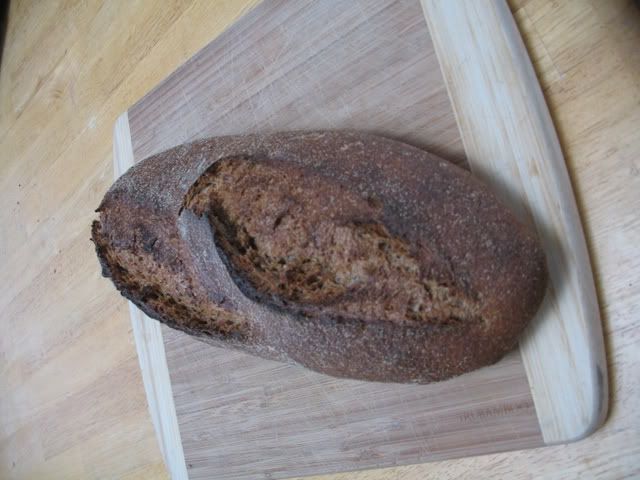
Here's the loaf just before it went into the oven.
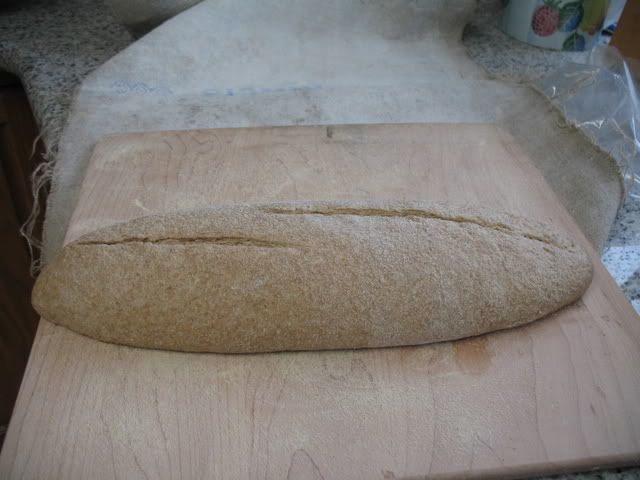
And the innards.
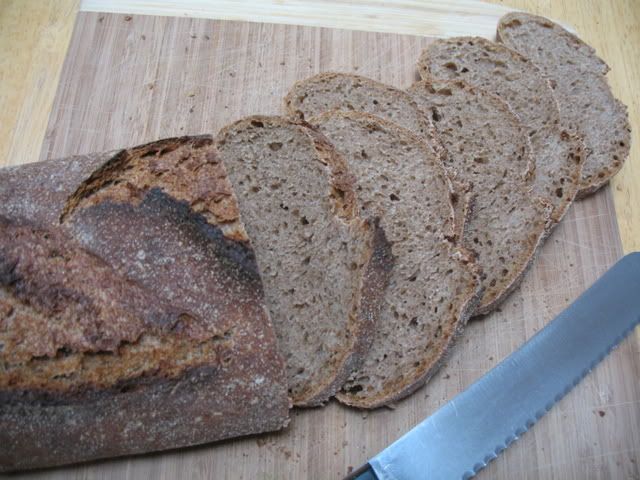
This bread has quickly become my "daily bread," the loaf I make most often, whether for dinner or sandwiches.
I also took a shot at my own variant of the Dragon's Breath Bread that Eric Hanner posted several weeks back. I tried to make a 50% whole wheat ciabatta with sauteed garlic cloves and cheddar cheese chunks. It was an interesting experiment and made a killer sandwich, but next time, I think I'll chop the cloves up a bit and not bother with trying for ciabatta. As you can see, it didn't turn out exactly as I'd hoped, especially since part of the loaf stuck to the peel:
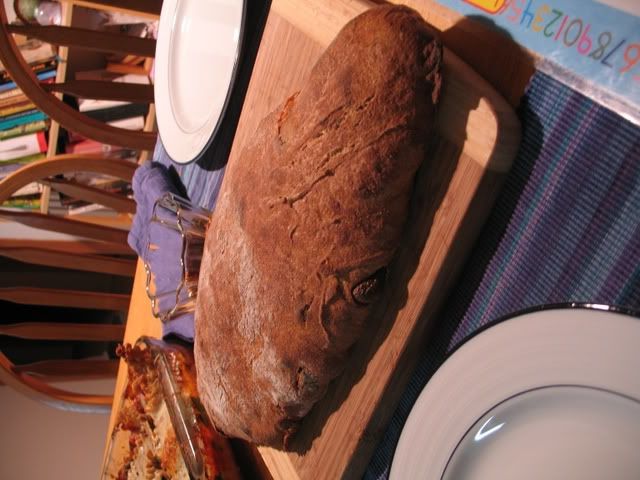
And the crumb ...
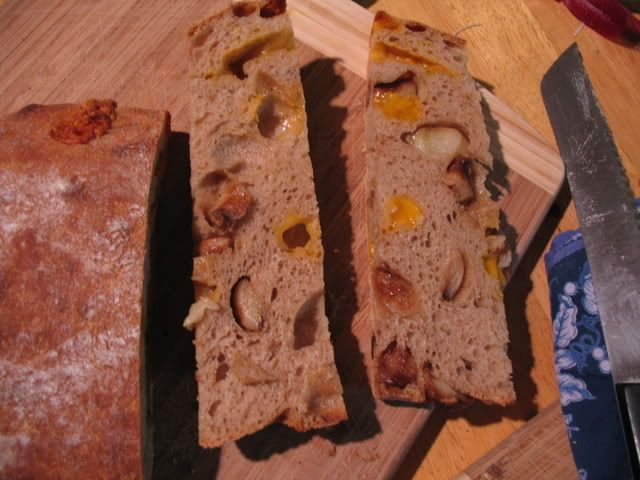
Thanks, Eric, for posting that recipe. Was fun!

Here's the loaf just before it went into the oven.

And the innards.

This bread has quickly become my "daily bread," the loaf I make most often, whether for dinner or sandwiches.
I also took a shot at my own variant of the Dragon's Breath Bread that Eric Hanner posted several weeks back. I tried to make a 50% whole wheat ciabatta with sauteed garlic cloves and cheddar cheese chunks. It was an interesting experiment and made a killer sandwich, but next time, I think I'll chop the cloves up a bit and not bother with trying for ciabatta. As you can see, it didn't turn out exactly as I'd hoped, especially since part of the loaf stuck to the peel:

And the crumb ...

Thanks, Eric, for posting that recipe. Was fun!
- JMonkey's Blog
- Log in or register to post comments
That loaf is beautiful, JMonkey, and very European looking with the gorgeous dark brown crust. Great bake!
Here I am trying to catch up on TFL and I just saw your simply incredible yeasted white breads and now you remind me I should try your recipe for this. I have not had the best luck with the WW I've baked so far with the exception of the Thom Leonard Country French which uses the high extraction flour I love so much. It isn't the bread that is the problem so much as the flavors I'm not so keen on so I need an excuse to use some new whole wheat flour I bought from Heartland Mill to try and compare. So I think your recipe should be the one. I don't have a whole wheat starter though so do I need to build my white one into a WW before baking with that amount or can I just use the starter I have?
I love your garlic bread, too. I have made the Della Fattoria one in Glezer's book many times which uses a garlic/cheese paste and it is out of this world!
Oh, and thanks! I think I've come around to MountainDog's point of view -- her husband likes his bread "bien cuit" and I'm finding that I do, too. A nice, dark crust has lots of crunch and a better flavor, I think.
Well done is tastier. Another beautiful loaf, JMonkey.
Susan from San Diego
Not sure what that means but it sure sounds good! I always bake my breads darker and I'm sure that is influenced by learning on Glezer's ABAA. I really miss MountainDog, dreadfully so, and wish she were posting here again.
Thanks for the info on the starter. I will let you know how my bread turns out.
Your whole grain sourdough is beautiful! And the sauteed garlic cloves look scrumptious.
Hello JMonkey,
I have been baking with whole grains (almost exclusively) for about a year. I have 50 pound pails of white wheat, red wheat, millet, kamut, durum, spelt, amaranth, rye and soft wheat. I've browsed around and have been looking for more information on the stretch and fold. I have to say that I'm still sooo frustrated with the inconsistencies. I have never taken a baking course, and I find that what is most frustrating for me is not understanding if my dough is as "stiff" or as "wet" as the recipe describes. I have Laurel's book and have SCOURED that first chapter where she talks about the feel of the bread. I'm at such a loss, and I'm writing to you to get any recommendations/advice on how to better gauge that. Also, where did you learn to translate the % of hydration? I'm definitely a math whiz, (took over 5 calculus classes) but I'm baffled at converting starters from the 100% that it is now to something as specific as 68-69%.
If you have a few moments to mentor someone on the minutiae of whole grain baking, I would be so grateful. Even for just a couple of pointers!
My email address is Melissa.Leray@gmail.com I tried finding an email address for you on here, and couldn't locate one, as I didn't feel that this was generally related to your dragon breath bread, but I didn't see another way to post to you.
I currently have a sourdough starter that I made from crust and crumb, and have tried over the last two days to convert it to a whole wheat starter, and it just seems so wet. Again, I am using 100% hydration. And the hooch is forming at the bottom, which I never noticed on the bread flour version that I started with.
I also flopped this week when I made the 100% spelt loaf out of Local Breads, I don't even know what happened there, it seemed that I was missing at least a cup of flour, maybe I actually forgot it? Such a flop! A true brick.... it was SO wet, I mean, so wet as to not hold an ounce of shape.
I have had decent success at PR's Broom Bread, and its so tasty, but the first loaf I tried came out way to wet still in the center, and the second loaf I baked longer to avoid that, but just seemed so dry because it had baked longer. I'll keep trying because of the taste... but I'm just feeling a bit frustrated.
Any tips/resources you could throw my way would be *so* appreciated.
Melissa
Melissa.Leray@gmail.com
Melissa in Atlanta
Scales: You don't absolutely need one to bake good bread, but I find it helps me a lot. I like the Escali, but others have sworn by MyWeigh. I wouldn't recommend Salter, as a lot of folks, including myself, have had problems with them. The weight of a cup of flour differs quite a bit from person to person, and even cup to cup, and it can make a huge difference in your results. By weighing, you can get the exact hydration that a recipe specifies and, over time, you'll get a feel for the difference between a slack dough and a stiff one.
Baker's Math: Baker's math is a way of breaking down ingredients into proportions so that one can scale up or down as needed. It also makes baking much easier because, once you understand the basic proportions, you can freely mix and match ingredients to create all kinds of breads. Every ingredient is expressed in terms of the flour weight, which is always expressed as 100 percent. For example, let's take a typical formula for French Bread:
- Flour: 100%
- Water: 66%
- Salt: 2%
- Fresh yeast: 2%
- Total: 170%
Let's say we want to make 1 kilogram of dough. First, we need to figure out how much flour we need. To do this, we dived the total percentage into the total weight of the dough: 1000 grams / 1.7 = 588 grams of flour( rounded to nearest gram).Next, we figure out the weight of each of the ingredients by multiplying their percentage by the flour weight.
Converting stiff starter to wet: Not as hard as one might think. Let's say you've got 80 grams of starter at 60% hydration and you want to feed it so that you get 300 grams of starter at 100% hydration.
First, figure out how much flour you've got in your starter. In the stiff starter, that's 80 grams / 1.6 (that's the total percentage, with 100% for the flour and 60% for the hydration). You get 50 grams of flour, which leaves 30 grams of water.
Next, figure out what you need in the 300 grams of starter at 100% hydration. How much flour do we have? Divide 300 grams by the total percentage, which is 200% (100% for the flour plus 100% for the water). 300 / 2.0 = 150 grams of flour. And that, of course, means we also need 150 grams of water.
Now, the feeding. Just subtract what you already have (50 grams flour and 30 grams water) from what you need (150 grams flour and 150 grams water).
- Flour for feeding = 150 - 50= 100 grams flour
- Water = 150 - 30 = 120 grams water
So, in sum, you take your 80 grams of stiff starter and add 120 grams water and 100 grams flour. Voila! You've got 300 grams of starter at 100% hydration.Feel free to post here for questions. You can email me, of course, but I'm sure there are others who have the same challenges. jfrankmillerDONTSPAMMEBRO@gmail.com
Just remove the obivious ....
Hi again!
One quick question regarding the conversion of a stiff starter to a wetter one... given the example you used above... going from 80gm to 300gm.. after that one "feeding" of the 100gm flour and 120gm water, do you let it rise at room temp for 4-8 hours until doubled, or do you use it immediately? If it sits at room temp and rises, does the weight change that you now have more than the 300gm you initially needed? or is it merely aerated, and doesn't actually weigh any more than before?
I'm feeling like an uber-doofus right now because I'm realizing that the starter that I "thought" i was mainintaing at 100% was not... more like 170% because I was measuring based on volume and not weight! argh! Anyway, that might explain why it would only rise about 60% and started having a liquid layer relatively quickly sitting on the counter. It was soaked! Not quite watered down... but 8oz water to 4.5 oz flour... sheesh! Maybe fixing that will also improve the smell... it was so strongly alcoholic!
Thank you, as always :)
Melissa in Atlanta
After converting to stiff starter, you definitely need to let it ripen. As for when it's ready, I don't bother too much with following volumes. I usually feed it the night before and use it the next morning. When the stiff stuff is ripe, it'll weigh the same, but will be spongy and much more loose than it was when you first mixed it up.
Does that help?
I don't recommend that, though. All the same, no harm in trying to revive it. Just take a small bit -- say 10-20 grams -- and add 100 grams water and 100 grams flour. Leave it for a day. Then twice a day, take about 20 grams and feed it 100 grams water and 100 grams flour.
If it doesn't revive in 3 or 4 feedings, it's probably kaput.
That help?
JMonkey,
I notice several posts from you yesterday. Glad to see that you are still around and baking.
Paul